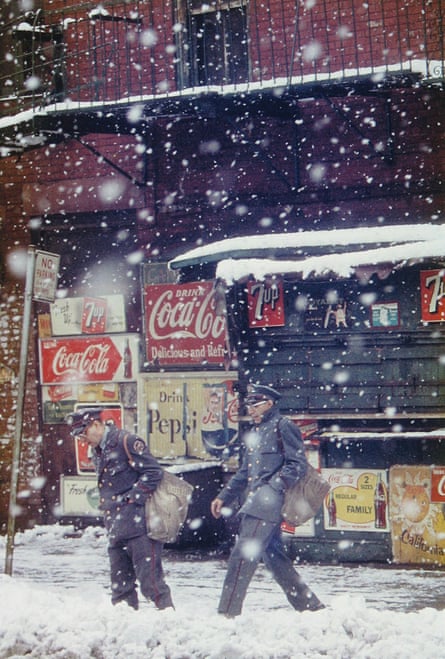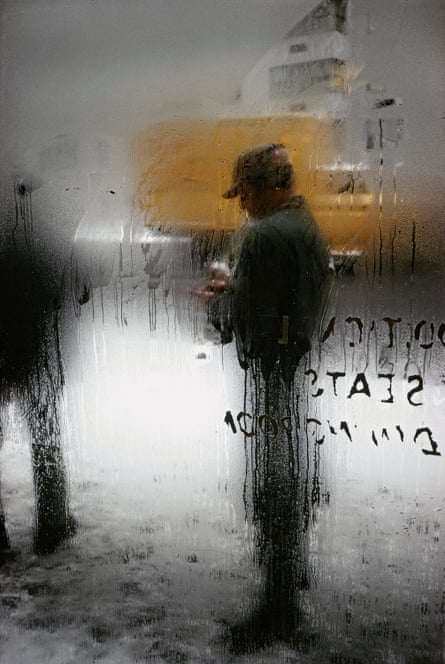‘I simply looked at the world, not prepared for anything,” Saul Leiter said towards the end of his life. That sense of unhurriedness, coupled with a painterly eye for colour and composition, is palpable in his evocative colour photographs of New York. There is also an attentiveness that speaks of his disinterest in anything other than making the seemingly mundane world around him seem luminously beautiful.
By the time he was “discovered” in 2006 with the publication of a book, Early Colour, he was 82. He had been working quietly for almost 60 years, first in monochrome, as a photojournalist, then in the 1950s, turning to colour to capture the rhythm and stillness of the same few streets around his Manhattan apartment in the soft, deep tones of Kodachrome slide film.

Leiter’s late recognition brought him the kind of attention he had long avoided. In Tomas Leach’s thoughtful documentary, In No Great Hurry: 13 Life Lessons With Saul Leiter, he emerges as a reluctant object of attention. “What makes them think I’m any good?” he asks. In a sublime retrospective at the Foto Colectania gallery in Barcelona, there are 130 answers to that question, almost every one a testament to his singular talent. In Search of Beauty, which is currently drawing hushed and reverent crowds to the newly relocated gallery in Passeig Picasso, is a well-nigh perfect overview of Leiter’s career. In many ways, it is the perfect space for his deeply crafted images: the gallery is in a converted saddler’s that retains an artisanal atmosphere, with its wood-panelled offices and library enclosing a simple square space.
Curator Roger Szmulewicz has wisely chosen to lead with Leiter’s signature colour photographs of Manhattan. Arranged in a single line around the perimeter, each one is a study in form, colour and atmosphere. This is not the overcrowded, fast-paced New York later caught by the likes of Garry Winogrand or Joel Meyerowitz. Instead, what Leiter captures, and heightens, is the atmosphere of another, older Manhattan – an almost sedate place, sometimes suffused with warm summer light, sometimes blanketed by falling snow.
Often he shoots through steamed windows or catches a passing reflection. His subjects are stilled in a moment of reverie, waiting at traffic lights or daydreaming in a stalled vehicle. Sometimes he shot at night or at twilight, just as the light was fading, so that people appear as ghostly silhouettes against the deep reds and greens of advertising billboards and neon shop signs. He isolates lone human figures in stark relief against snow or rain. Umbrellas are a recurring motif, their circular geometry irresistibly drawing the eye, like a splash of red or orange in an impressionist painting. He was constantly alert, too, to the typographical poetry of street signs and lettering stencilled on shop windows. It all adds up to an intimate portrait of a time, a place and its passing people.

The son of an Orthodox rabbi who fled the constrictions of a traditional Jewish upbringing in Pittsburgh to try to become an artist in mid-1940s New York, Leiter never lost his painter’s eye for colour and composition. Some of his images approach the purely abstract: shadows against blurred orange lights; a dark silhouette just identifiable against a blur of passing cars; people and things partially obscured by shadowy objects in the foreground. The result is a strange hybrid of intimate observation and heightened atmosphere, the creation of a New York that is familiar and slightly unreal in the way that certain paintings of the city are unreal – Edward Hopper’s work springs to mind. Leiter was a photographer possessed of a painter’s sensibility. He even made a series of painted nudes, applying paint on top of his photographic portraits to often vibrant effect.
It is hardly surprising then, that in the earlier black and white work, New York seems like another city – more ghostly and gritty, less dreamlike. Here, too, Leiter plays with form, homing in on silhouettes, catching shafts of geometric light as they fall on faces and torsos. To some degree, that painter’s eye informs every photograph. Even more revelatory are the series of recently discovered intimate portraits, many of them collected in the new Steidl photo book, In My Room.

In the 1950s and into the early 60s, Leiter photographed the women he knew – including his longtime partner-muse, Soames Bantry, and several of her model friends – mostly in his New York studio.
The portraits, in grainy black and white, are certainly erotic, but in an almost languorous way. He captures his subjects in motion or in repose, sometimes seemingly unaware of his gaze, sometimes returning it with a provocative or accepting look. The few full nudes are the most abstract images, shadows falling on skin, the prints grainy and high contrast. Again, many of the images were taken through doors or screens, giving the sense of glimpsed intimate snapshots – except his compositional skill is so consistently finely honed as to make the term seem almost insulting. There is a relaxed intimacy to them that speaks of thoughtful collaboration between photographer and subject.
After such richness, the single wall of Leiter’s colour fashion photography seems almost superfluous. One can see he was too singular an artist to be at ease in such a commercial sphere, yet he succeeds in making portraits that, as he put it later, looked “like a photograph rather than a fashion photograph”. More interesting still is the small collection of ephemera, in the wood-panelled library next door, that includes family snapshots, a sketchbook and palette knives.
Half a dozen quotes by Leiter are stencilled on the walls of the gallery. One reads: “There is a tremendous advantage of being unimportant.” Another reads: “In some secret place in my being was a desire to avoid success.” Both give you some idea of Leiter’s temperament and the ways it informed the unhurried pursuit of his art. The almost devotional hush in the gallery as people peer at these images is testimony to a life devoted to the quiet pursuit of a singular vision and the avoidance of such distractions as fame or even recognition. For Leiter, simply looking at the world was enough.
- Saul Leiter: In Search of Beauty is at Foto Colectania, Barcelona, until 21 October.
